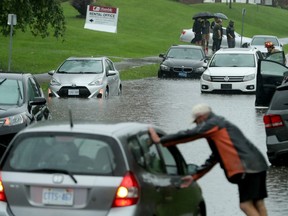For the second year in a row, Ottawa received more weather alerts than any of Canada’s 23 major cities.

Article content
Ottawa set a national record for weather alerts last year as the storm-tossed capital faced 66 weather warnings and advisories.
Environment and Climate Change Canada data shows Ottawa narrowly beat its own record, established in 2022, when the city was the subject of 65 weather alerts.
It means that, for the second year in a row, Ottawa received more weather alerts than any of Canada’s 23 major cities.
Advertisement 2
Story continues below
Article content
According to Environment Canada’s data table for 2023, Ottawa was followed by Windsor with 57 weather alerts, Toronto (52), Sudbury (48), Halifax (43), Quebec City (42) and Fredericton (39).
The data table represents one measure of Ottawa’s increasingly volatile weather.
Nicole Allen, an Environment Canada spokesperson, noted that the numbers have to be interpreted with caution since a single alert can be issued for a severe weather event that lasts one hour or all day. In other words, a weather alert does not always reflect the impact of an event.
“Because of this,” she said, “the number of alerts listed does not necessarily reflect whether a city is receiving more or less severe weather in a particular year, or whether the severe weather it has received has been more impactful.”
The weather alert data table ranks the country’s largest urban areas, with at least one city from each province and territory.
In 2022, Ottawa became the weather alert capital of the country for the first time. Quebec City had previously dominated the weather alert table, holding top spot in seven of the 10 years between 2012 and 2021.
Advertisement 3
Story continues below
Article content
The rules that govern the issuance of weather alerts vary from place to place in Canada.
In Iqaluit, for instance, a weather warning is issued for extreme cold only if the temperature is expected to reach -50 C for at least two hours, while in Ottawa it’s issued when the temperature is expected to dip to -35 C for at least two hours. In Montreal, the standard is -38 C.

Similarly, Ottawa will receive a snowfall warning if 15 centimetres of snow is expected to fall within a 12-hour period. In parts of B.C., Alberta, Manitoba and Saskatchewan, a warning is triggered if 10 cm is expected.
The system is designed to account for the way people have acclimatized to their local weather conditions.
Last year, Ottawa experienced some dramatic and damaging weather events.
On April 5, a spring storm dumped nine hours of ice pellets and freezing rain (25-30 millimetres) on the city. Gusting winds brought down tree branches and electrical wires, leaving more than 163,000 homes and businesses—– 45 per cent of Hydro Ottawa’s customer base — without electricity. Five of the city’s LRT trains had to be abandoned on their tracks.
Advertisement 4
Story continues below
Article content
A warm, dry spring created dangerous forest conditions in northern Ontario and Quebec, where massive forest fires burned out of control for weeks. The resulting smoke blanketed Ottawa for days in June, and left the city with some of the worst air quality in the world.
The summer brought intense thunderstorms and several tornadoes to Ottawa, all of which triggered weather alerts.
Two tornadoes touched down in Barrhaven on July 13, and another hit the Findlay Creek area on Aug. 3. The Barrhaven tornadoes, which packed winds of up to 155 km/h, damaged more than 120 homes, uprooted trees, downed power lines and scattered debris.

An intense storm on Aug. 10 swamped the city: A weather station at the Central Experimental Farm recorded 77 mm of rain in five hours. The downpour overwhelmed the city’s $232-million stormwater storage tunnel, sending 316 million litres of sewage-contaminated water pouring into the Ottawa River.
Environment Canada’s data shows Ottawa has been among the top four cities for weather alerts in each of the past eight years. During that time, it had no fewer than 46 weather warnings and advisories.
Advertisement 5
Story continues below
Article content
In the four years before that, however, Ottawa averaged just 32 weather alerts a year.
In 2016, the number of weather alerts issued for Ottawa jumped to 50.
That sudden rise may be partially explained by the fact Environment Canada changed its approach to the issuance of heat warnings in Ontario in May 2016 to better account for the health threat posed by heat waves.

The increased volatility in Ottawa weather evinced by the data table is broadly consistent with predictions made about the impact of climate change on the National Capital Region.
The National Capital Commission (NCC) and the City of Ottawa commissioned a joint study to examine how the region is likely to be affected by climate change. Published in 2020, the study forecast a warmer and wetter climate, even if greenhouse gas emissions grow at a moderate rate in the coming decades.
Higher temperatures are expected throughout the year along with more precipitation in every season except summer. Summers are projected to be hotter, drier and more humid.
“Conditions favourable for extreme events such as freezing rain, tornadoes and wildfires are projected to be more common,” the study concluded.
Recommended from Editorial
Article content


Comments